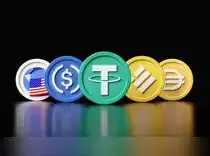This year is proving to be something of a “ChatGPT moment” for stablecoins. But while the excitement is palpable, their utility is still unclear. They are useful to exchange fiat money for speculative assets like Bitcoin. However, outside the world of cryptocurrencies, why would anyone want to hold tokens that are prohibited from paying their users anything?
The upcoming US regulations for these 1:1 blockchain copies of the greenback have led to aggressive forecasts of where the $260 billion market is headed. Some of that enthusiasm is visible in Circle Internet Group Inc.’s shares, which have risen sixfold over their $31 initial public offering price last month. Circle’s USDC is the second-most-popular digital dollar after Tether’s USDT.
Stablecoins are also benefiting from a general crypto rush, with Bitcoin soaring to a record $120,000 this week. The higher the price of the industry bellwether, the greater the demand for digital dollars to trade the asset efficiently in spot and derivative markets.
 However, to turbocharge mass adoption and propel the market to $3 trillion or more by 2030, requires precisely what authorities nearly everywhere, including the US, will not allow: yield-bearing stablecoins.
However, to turbocharge mass adoption and propel the market to $3 trillion or more by 2030, requires precisely what authorities nearly everywhere, including the US, will not allow: yield-bearing stablecoins.
The thinking is that these tokens are private representations of sovereign money. To fulfil their promise of converting on par to government-issued currency, issuers must park their funds in liquid short-dated treasury bills and earn returns only for their shareholders. Should they be permitted to also produce a yield for depositors, they would become lightly regulated shadow banks, enticing customers by taking risks that may not always be apparent to authorities.
But the industry will not be stymied by such obstacles. While regulated stablecoins themselves may not pay interest, they can offer near-instantaneous, two-way exchange into something that can. And that product is a tokenised money-market fund. Earlier this year, Circle acquired Hashnote, the issuer of USYC, a yield-bearing coin backed by short-term US Treasury securities.
Suppose a crypto enthusiast wants to buy a Bitcoin option. She can convert her USDC to USYC, and use it to fund her account the same day at Deribit, a popular crypto derivatives exchange. The collateral will earn interest that USDC can’t. With tokenised funds, transfers can occur instantly, with “dividends calculated precisely, down to the second.”
As much as $5.7 trillion of cash is sitting in traditional government money-market funds that invest in US Treasuries. It isn’t just the crypto upstarts circling around the huge market. Large asset managers are offering their own blockchain products. BlackRock Inc.’s BUIDL fund tokens are now acceptable collateral at both Deribit and Crypto.com. Franklin Templeton has brought its tokenised US dollar money-market fund to Singapore’s retail investors. In Hong Kong, existing money-market funds are starting to offer new shares on the blockchain. There may be more of these when the city starts issuing licenses for Hong Kong dollar stablecoins.
The market value of stablecoins currently, when they’re dominated by USDT and USDC, is approaching 5% of government money-market funds. Expect that figure to rise as new players enter, offering seamless swaps between digital dollars and yield-bearing tokenised funds.
In a high-interest-rate environment, stablecoin demand suffers because of the opportunity cost of holding an instrument that pays nothing. A combo package, in which stablecoins are preferred for payments and money-market funds are used to post collateral, is the likely future of digital money. Tokens that offer convertibility at par into the sovereign unit of account while paying market rates of interest will potentially reshape the stablecoin market, the Bank for International Settlements said in a bulletin last week.
For financial regulators, that may not be a blessing. As Yale School of Management finance professor Gary Gorton and former Federal Reserve attorney Jeffery Zhang pointed out in their 2021 paper, Taming Wildcat Stablecoins, money-market funds, which have avoided being regulated as bank deposits, had to be bailed out twice in just over a decade: during the 2008 crisis, and when Covid-19 struck. “If policymakers wait a decade, stablecoins might become a multitrillion-dollar industry — too big to fail — and the government will have to step in with a rescue package whenever there’s a financial panic.”
Also read: Mutual funds dump Rs 1,700 crore worth of 9 defence stocks. Too expensive to buy or smart exit?
Pressure from the industry is going to push authorities to accept that risk. Eventually, the crypto world’s cash will pay interest by the back door. That’s when stablecoins will go truly mainstream and become a raging headache for regulators worldwide.
The upcoming US regulations for these 1:1 blockchain copies of the greenback have led to aggressive forecasts of where the $260 billion market is headed. Some of that enthusiasm is visible in Circle Internet Group Inc.’s shares, which have risen sixfold over their $31 initial public offering price last month. Circle’s USDC is the second-most-popular digital dollar after Tether’s USDT.
Stablecoins are also benefiting from a general crypto rush, with Bitcoin soaring to a record $120,000 this week. The higher the price of the industry bellwether, the greater the demand for digital dollars to trade the asset efficiently in spot and derivative markets.
Crypto Tracker

TOP COIN SETS
NFT & Metaverse Tracker
28.95%
Buy
Web3 Tracker
19.47%
Buy
AI Tracker
15.31%
Buy
DeFi Tracker
11.90%
Buy
Crypto Blue Chip - 5
9.23%
Buy
TOP COINS (₹)
Ethereum
271,012 (5.76%)
Buy
XRP
252 (2.61%)
Buy
Solana
14,065 (2.1%)
Buy
BNB
59,240 (1.24%)
Buy
Bitcoin
10,136,625 (0.93%)
Buy
Did you Know?
The world of cryptocurrencies is very dynamic. Prices can go up or down in a matter of seconds. Thus, having reliable answers to such questions is crucial for investors.
But the industry will not be stymied by such obstacles. While regulated stablecoins themselves may not pay interest, they can offer near-instantaneous, two-way exchange into something that can. And that product is a tokenised money-market fund. Earlier this year, Circle acquired Hashnote, the issuer of USYC, a yield-bearing coin backed by short-term US Treasury securities.
Suppose a crypto enthusiast wants to buy a Bitcoin option. She can convert her USDC to USYC, and use it to fund her account the same day at Deribit, a popular crypto derivatives exchange. The collateral will earn interest that USDC can’t. With tokenised funds, transfers can occur instantly, with “dividends calculated precisely, down to the second.”
As much as $5.7 trillion of cash is sitting in traditional government money-market funds that invest in US Treasuries. It isn’t just the crypto upstarts circling around the huge market. Large asset managers are offering their own blockchain products. BlackRock Inc.’s BUIDL fund tokens are now acceptable collateral at both Deribit and Crypto.com. Franklin Templeton has brought its tokenised US dollar money-market fund to Singapore’s retail investors. In Hong Kong, existing money-market funds are starting to offer new shares on the blockchain. There may be more of these when the city starts issuing licenses for Hong Kong dollar stablecoins.
The market value of stablecoins currently, when they’re dominated by USDT and USDC, is approaching 5% of government money-market funds. Expect that figure to rise as new players enter, offering seamless swaps between digital dollars and yield-bearing tokenised funds.
In a high-interest-rate environment, stablecoin demand suffers because of the opportunity cost of holding an instrument that pays nothing. A combo package, in which stablecoins are preferred for payments and money-market funds are used to post collateral, is the likely future of digital money. Tokens that offer convertibility at par into the sovereign unit of account while paying market rates of interest will potentially reshape the stablecoin market, the Bank for International Settlements said in a bulletin last week.
For financial regulators, that may not be a blessing. As Yale School of Management finance professor Gary Gorton and former Federal Reserve attorney Jeffery Zhang pointed out in their 2021 paper, Taming Wildcat Stablecoins, money-market funds, which have avoided being regulated as bank deposits, had to be bailed out twice in just over a decade: during the 2008 crisis, and when Covid-19 struck. “If policymakers wait a decade, stablecoins might become a multitrillion-dollar industry — too big to fail — and the government will have to step in with a rescue package whenever there’s a financial panic.”
Also read: Mutual funds dump Rs 1,700 crore worth of 9 defence stocks. Too expensive to buy or smart exit?
Pressure from the industry is going to push authorities to accept that risk. Eventually, the crypto world’s cash will pay interest by the back door. That’s when stablecoins will go truly mainstream and become a raging headache for regulators worldwide.





